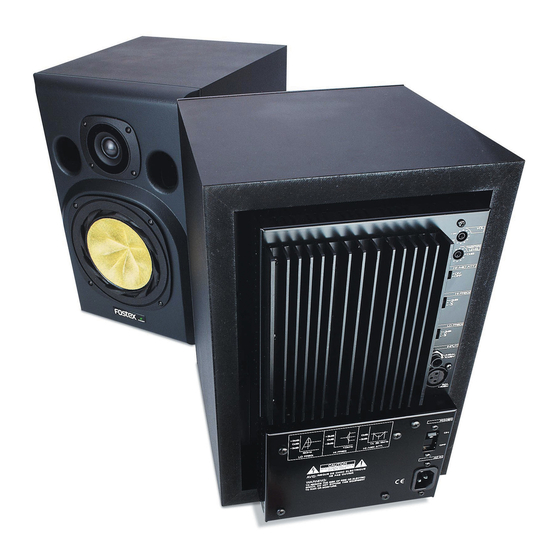
Fostex NF-1 Technical White Paper
Near field studio monitor
Hide thumbs
Also See for NF-1:
- Technology white paper (85 pages) ,
- Service manual (10 pages) ,
- Owner's manual (4 pages)
Advertisement
Quick Links
Advertisement

Summary of Contents for Fostex NF-1
- Page 1 Technical White Paper NEAR FIELD STUDIO MONITOR...
- Page 2 - 2 -...
- Page 3 In recent years, cases abound where small speakers are used in the near field. NF-1 has been developed to incorporate the following elements as the engineering development themes necessary not to miss any of these 5 points.
- Page 4 Our purpose and reason for the world's first application of this HP structure to the NF-1 near- field monitor as an ideal diaphragm configuration can be explained by 3 acoustic advantages which were not available from conventional diaphragms.
- Page 5 One of the properties of the HP structure is the unlikelihood of development of inherent timbre because of widely dispersed resonance. This finding has made it possible to use, without encountering any particular major resonance, materials such as metal and carbon fibers having high propagation velocity and low tan (internal loss) which used to be regarded as properties to be overcome.
- Page 6 1) Propagation speed 2) Modulus of flexural rigidity 3) Internal loss (tan ) For NF-1 diaphragms, we have set the following target values, which we think the next generation near-field monitors cannot be without. Propagation speed:3000 m/sec., minimum. Conventional pulp materials:2600 m PP (polypropylene):1290 m Modulus of flexural rigidity:6.0 (2 times...
- Page 7 B) Enforcement material A: Carbon fiber of a super high elasticity modulus Cases abound where carbon fibers are used for cones. The carbon fibers contained in NF-1 cones combine the property of super high elasticity modulus working as an enforcement material. With...
- Page 8 G) Secondary impregnant Sound quality of wood pulp cones is said to fluctuate depending on ambient humidity. The woofer for NF-1 is engineered to be humidity- resistant to an extent incomparable to previous wood pulp-based vibratory systems, by using special nitrocellulose materials capable of...
- Page 9 They are fated to be a source of changes in sound quality due to seasonal temperature changes. The woofer found in NF-1 is the incomparably successful compilation of our 50-year long research and development efforts for elementary technologies in wood pulp-based diaphragms.
- Page 10 Reduction in No resonance is observed on the entire circumference, nor is there any anti-resonance axis-symmetry resonance. at high frequencies: Added strength and a shift to disperse at high frequencies prevent any Figure 9 natural high peaks from being generated, in contrast to rolled edges.
- Page 11 4) Double-damper of a push-pull structure The suspension function of dampers is to always keep a voice coil centered. NF-1, the target for which is perfection of every function of it, employs a double-damper which is advantageous in view of structure but very time consuming to produce, and is seen mostly in expensive speaker systems.
-
Page 12: Features Of The Enclosure
NF-1 is designed for optimal sound when listened to at positions between the axes of the woofer and the tweeter, if connected in phase. In the case of opposite... - Page 13 NF-1, very unlike other 11 liter volume enclosures, uses a 21 mm thick MDF material to add extraordinary rigidity to it. Our concern for rigidity is especially apparent in the front baffle to which the woofer is mounted.
- Page 14 The use of a high quality film capacitor and a 1.5 mm diameter solid wire is another factor for this superb transition. 2) Bi-wiring Successful achievement of our targets set for NF-1 listed below requires use of a bi-wiring system. - 14 - (woofer unit only) With glass wool...
-
Page 15: Technical Specifications
a. For ideal driving of speakers, a 4-terminal structure is necessary to allow for independent connections. b. To enable connection of a single amplifier to each speaker driver, with a wire most appropriate for each speaker. c. To allow to attain, by reversing the phase, characteristics most suitable for the specificlistening environment. - Page 16 Fostex Corporation, 3-2-35 Musasino, Akisima, Tokyo, Japan 196-0021 Tel: +81(0)42-546-4974 Fax: +81(0)42-546-9222...














Need help?
Do you have a question about the NF-1 and is the answer not in the manual?
Questions and answers